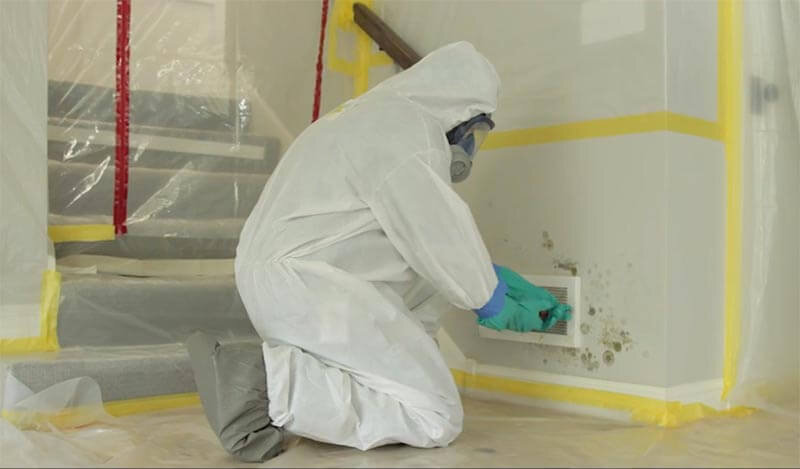Comprehensive Post Mold Remediation Procedures
Comprehensive Post Mold Remediation Procedures
Blog Article
Your Ultimate Guide to Message Mold Remediation Techniques
Navigating the world of post-mold removal strategies is a thorough procedure that requires attention to detail and an extensive understanding of the intricacies entailed. In the after-effects of mold and mildew invasion, knowing just how to properly eliminate the mold and avoid its reoccurrence is extremely important for keeping a healthy and balanced indoor atmosphere. From choosing the best cleansing and decontaminating techniques to carrying out methods for long-lasting mold and mildew prevention, each action in the remediation trip plays a vital duty in making sure an effective outcome. As we start this exploration of post-mold remediation methods, we will uncover the crucial techniques and finest practices that can aid you restore your room to its pre-mold condition and safeguard it versus future mold and mildew dangers.
Comprehending Post-Mold Removal Refine
After finishing the mold and mildew removal procedure, it is critical to understand the post-mold remediation techniques that are necessary to ensure a reliable and thorough cleaning. As soon as the mold and mildew has actually been eliminated, the next step involves cleaning and disinfecting the affected locations to prevent any regrowth of mold. This consists of utilizing specialized cleaning up agents to wipe down surface areas and eliminate any type of remaining mold spores. It is important to dry the location completely to dissuade the growth of mold and mildew in the future (Post Remediation Inspection near me). Correct air flow and dehumidification can help in this procedure.
In addition, carrying out a final inspection post-remediation is crucial to make sure that all mold and mildew has been effectively gotten rid of. If the examination discloses any type of remaining mold, additional remediation might be essential.
Effective Cleansing and Sanitizing Techniques

Preventing Future Mold Development

Significance of Proper Air Flow
Proper air flow plays an important function in preventing dampness accumulation, a key consider mold growth within interior environments. Effective air flow systems aid eliminate excess moisture from the air, minimizing the chances of mold and mildew spores finding the dampness they need to spread out and sprout. Without ample air flow, indoor rooms can end up being a breeding ground for mold and mildew, causing potential health and wellness threats and architectural damages.
By making sure proper air flow, air flow systems can likewise aid in drying out moist locations quicker after water damage or flooding occurrences, further preventing mold and mildew growth. Post Mold Remediation Report. In spaces like restrooms, basements, kitchen areas, and attic rooms where moisture levels tend to be greater, setting up and keeping reliable air flow systems is essential in avoiding mold and mildew problems

Surveillance and Upkeep Tips
Provided the vital role that correct air flow plays in stopping mold development, it is essential to develop efficient monitoring and upkeep ideas to guarantee the ongoing performance of air flow systems. Routine inspections of air flow systems ought to be performed to look for any kind of indications of blockages, leakages, or malfunctions that can hinder correct air flow. Monitoring humidity degrees within the residential or commercial property is additionally important, as high humidity can add to mold and mildew growth. Mounting a hygrometer can assist track moisture levels and alert homeowners to any type of spikes that may call for focus. In addition, making certain that air filters are routinely cleaned or changed is important for preserving the efficiency of the ventilation system. Carrying out a schedule for regular upkeep tasks, web link such as duct cleansing and a/c system examinations, can help stop concerns before they intensify. By remaining alert and aggressive to the condition of air flow systems, building proprietors can efficiently alleviate the threat of mold and mildew regrowth and preserve a healthy and learn this here now balanced interior setting.
Conclusion
In conclusion, post-mold removal methods are necessary for making sure a clean and safe setting. Understanding the process, executing effective cleansing and decontaminating techniques, stopping future mold development, maintaining proper air flow, and regular monitoring are all important action in the removal process. By adhering to these standards, you can successfully get rid of mold and mildew and prevent its return, working or promoting a healthy living room for all passengers.
In the consequences of mold problem, understanding how to successfully eliminate the mold and mildew and avoid its reoccurrence is paramount for preserving a healthy indoor setting. Once the mold and mildew has been eliminated, the following step entails cleansing and sanitizing the influenced areas to protect against any regrowth of mold and mildew - testing air quality after mold remediation. After eliminating noticeable mold growth, it is vital to clean all surfaces in the affected area to remove any type of continuing to be mold spores. To additionally boost mold prevention procedures, click it is important to resolve underlying issues that at first led to mold advancement.Offered the vital function that correct ventilation plays in stopping mold growth, it is critical to develop reliable monitoring and maintenance ideas to make certain the ongoing functionality of air flow systems
Report this page